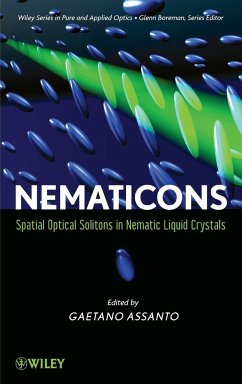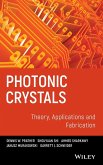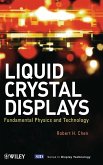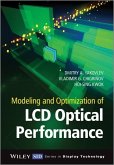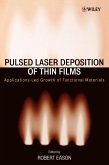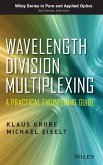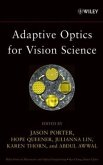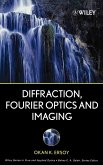- Gebundenes Buch
- Merkliste
- Auf die Merkliste
- Bewerten Bewerten
- Teilen
- Produkt teilen
- Produkterinnerung
- Produkterinnerung
Since the field of nematonics is relatively new, there is a need for a comprehensive introduction to nematonics theory and application. Nematonics Spatial Optical Solitons in Nematic Liquid Crystals breaks barriers of the field by being the first book of its kind to introduce the fundamentals, basic features and models, potential applications and novel phenomena and its important applications in liquid crystal technology. Recognized leader in the field Gaetano Assanto outlines the peculiar characteristics of nematicons and the promise they have for the future growth of this captivating new field.…mehr
Andere Kunden interessierten sich auch für
![Photonic Crystals, Theory, Applications and Fabrication Photonic Crystals, Theory, Applications and Fabrication]() Dennis W PratherPhotonic Crystals, Theory, Applications and Fabrication205,99 €
Dennis W PratherPhotonic Crystals, Theory, Applications and Fabrication205,99 €![Liquid Crystal Displays Liquid Crystal Displays]() Robert H. ChenLiquid Crystal Displays133,99 €
Robert H. ChenLiquid Crystal Displays133,99 €![Modeling and Optimization of LCD Optical Performance Modeling and Optimization of LCD Optical Performance]() Dmitry A. YakovlevModeling and Optimization of LCD Optical Performance128,99 €
Dmitry A. YakovlevModeling and Optimization of LCD Optical Performance128,99 €![Pulsed Laser Deposition of Thin Films Pulsed Laser Deposition of Thin Films]() Robert W. EasonPulsed Laser Deposition of Thin Films303,99 €
Robert W. EasonPulsed Laser Deposition of Thin Films303,99 €![Wavelength Division Multiplexi Wavelength Division Multiplexi]() Klaus GrobeWavelength Division Multiplexi159,99 €
Klaus GrobeWavelength Division Multiplexi159,99 €![Adaptive Optics for Vision Science Adaptive Optics for Vision Science]() Jason Porter / Hope Queener / Julianna Lin / Karen Thorn / Abdul A. S. AwwalAdaptive Optics for Vision Science287,99 €
Jason Porter / Hope Queener / Julianna Lin / Karen Thorn / Abdul A. S. AwwalAdaptive Optics for Vision Science287,99 €![Diffraction, Fourier Optics and Imaging Diffraction, Fourier Optics and Imaging]() Okan K. ErsoyDiffraction, Fourier Optics and Imaging199,99 €
Okan K. ErsoyDiffraction, Fourier Optics and Imaging199,99 €-
-
-
Since the field of nematonics is relatively new, there is a need for a comprehensive introduction to nematonics theory and application. Nematonics Spatial Optical Solitons in Nematic Liquid Crystals breaks barriers of the field by being the first book of its kind to introduce the fundamentals, basic features and models, potential applications and novel phenomena and its important applications in liquid crystal technology. Recognized leader in the field Gaetano Assanto outlines the peculiar characteristics of nematicons and the promise they have for the future growth of this captivating new field.
Hinweis: Dieser Artikel kann nur an eine deutsche Lieferadresse ausgeliefert werden.
Hinweis: Dieser Artikel kann nur an eine deutsche Lieferadresse ausgeliefert werden.
Produktdetails
- Produktdetails
- Wiley Series in Pure and Applied Optics Vol.1
- Verlag: Wiley & Sons
- Artikelnr. des Verlages: 14590724000
- 1. Auflage
- Seitenzahl: 456
- Erscheinungstermin: 5. November 2012
- Englisch
- Abmessung: 240mm x 161mm x 29mm
- Gewicht: 752g
- ISBN-13: 9780470907245
- ISBN-10: 047090724X
- Artikelnr.: 33762294
- Herstellerkennzeichnung
- Libri GmbH
- Europaallee 1
- 36244 Bad Hersfeld
- gpsr@libri.de
- Wiley Series in Pure and Applied Optics Vol.1
- Verlag: Wiley & Sons
- Artikelnr. des Verlages: 14590724000
- 1. Auflage
- Seitenzahl: 456
- Erscheinungstermin: 5. November 2012
- Englisch
- Abmessung: 240mm x 161mm x 29mm
- Gewicht: 752g
- ISBN-13: 9780470907245
- ISBN-10: 047090724X
- Artikelnr.: 33762294
- Herstellerkennzeichnung
- Libri GmbH
- Europaallee 1
- 36244 Bad Hersfeld
- gpsr@libri.de
GAETANO ASSANTO, PhD, is Professor of Optoelectronics at the University of Rome, where he heads the Nonlinear Optics and OptoElectronics Lab. He is Fellow of the Optical Society of America and a Senior Member of the IEEE Photonics Society.
Preface xv Acknowledgments xvii Contributors xix Chapter 1. Nematicons 1 Gaetano Assanto, Alessandro Alberucci, and Armando Piccardi 1.1 Introduction 1 1.1.1 Nematic Liquid Crystals 1 1.1.2 Nonlinear Optics and Solitons 3 1.1.3 Initial Results on Light Self-Focusing in Liquid Crystals 3 1.2 Models 4 1.2.1 Scalar Perturbative Model 5 1.2.2 Anisotropic Perturbative Model 9 1.3 Numerical Simulations 13 1.3.1 Nematicon Profile 13 1.3.2 Gaussian Input 14 1.4 Experimental Observations 17 1.4.1 Nematicon-Nematicon Interactions 22 1.4.2 Modulational Instability 26 1.5 Conclusions 31 References 33 Chapter 2. Features of Strongly Nonlocal Spatial Solitons 37 Qi Guo, Wei Hu, Dongmei Deng, Daquan Lu, and Shigen Ouyang 2.1 Introduction 37 2.2 Phenomenological Theory of Strongly Nonlocal Spatial Solitons 38 2.2.1 The Nonlinearly Induced Refractive Index Change of Materials 38 2.2.2 From the Nonlocal Nonlinear Schr
odinger Equation to the Snyder-Mitchell Model 39 2.2.3 An Accessible Soliton of the Snyder-Mitchell Model 42 2.2.4 Breather and Soliton Clusters of the Snyder-Mitchell Model 45 2.2.5 Complex-Variable-Function Gaussian Breathers and Solitons 46 2.2.6 Self-Induced Fractional Fourier Transform 47 2.3 Nonlocal Spatial Solitons in Nematic Liquid Crystals 49 2.3.1 Voltage-Controllable Characteristic Length of NLC 50 2.3.2 Nematicons as Strongly Nonlocal Spatial Solitons 52 2.3.3 Nematicon-Nematicon Interactions 54 2.4 Conclusion 61 Appendix 2.A: Proof of the Equivalence of the Snyder-Mitchell Model (Eq. 2.16) and the Strongly Nonlocal Model (Eq. 2.11) 61 Appendix 2.B: Perturbative Solution for a Single Soliton of the NNLSE (Eq. 2.4) in NLC 62 References 66 Chapter 3. Theoretical Approaches to Nonlinear Wave Evolution in Higher Dimensions 71 Antonmaria A. Minzoni and Noel F. Smyth 3.1 Simple Example of Multiple Scales Analysis 71 3.2 Survey of Perturbation Methods for Solitary Waves 77 3.3 Linearized Perturbation Theory for Nonlinear Schr
odinger Equation 81 3.4 Modulation Theory: Nonlinear Schr
odinger Equation 83 3.5 Radiation Loss 88 3.6 Solitary Waves in Nematic Liquid Crystals: Nematicons 91 3.7 Radiation Loss for The Nematicon Equations 96 3.8 Choice of Trial Function 101 3.9 Conclusions 105 Appendix 3.A: Integrals 106 Appendix 3.B: Shelf Radius 107 References 108 Chapter 4. Soliton Families in Strongly Nonlocal Media 111 Wei-Ping Zhong and Milivoj R. Beli
c 4.1 Introduction 111 4.2 Mathematical Models 112 4.2.1 General 112 4.2.2 Nonlocality Through Response Function 113 4.3 Soliton Families in Strongly Nonlocal Nonlinear Media 115 4.3.1 One-Dimensional Hermite-Gaussian Spatial Solitons 115 4.3.2 Two-Dimensional Laguerre-Gaussian Soliton Families 116 4.3.3 Accessible Solitons in the General Model of Beam Propagation in NLC 118 4.3.4 Two-Dimensional Self-Similar Hermite-Gaussian Spatial Solitons 125 4.3.5 Two-Dimensional Whittaker Solitons 126 4.4 Conclusions 133 References 135 Chapter 5. External Control of Nematicon Paths 139 Armando Piccardi, Alessandro Alberucci, and Gaetano Assanto 5.1 Introduction 139 5.2 Basic Equations 140 5.3 Nematicon Control with External Light Beams 142 5.3.1 Interaction with Circular Spots 143 5.3.2 Dielectric Interfaces 145 5.3.3 Comments 146 5.4 Voltage Control of Nematicon Walk-Off 147 5.4.1 Out-of-Plane Steering of Nematicons 147 5.4.2 In-Plane Steering of Nematicon 149 5.5 Voltage-Defined Interfaces 152 5.6 Conclusions 156 References 156 Chapter 6. Dynamics of Optical Solitons in Bias-Free Nematic Liquid Crystals 159 Yana V. Izdebskaya, Anton S. Desyatnikov, and Yuri S. Kivshar 6.1 Summary 159 6.2 Introduction 159 6.3 From One to Two Nematicons 160 6.4 Counter-Propagating Nematicons 162 6.5 Interaction of Nematicons with Curved Surfaces 165 6.6 Multimode Nematicon-Induced Waveguides 167 6.7 Dipole Azimuthons and Charge-Flipping 170 6.8 Conclusions 172 References 173 Chapter 7. Interaction of Nematicons and Nematicon Clusters 177 Catherine Garc
ýa-Reimbert, Antonmaria A. Minzoni, and Noel F. Smyth 7.1 Introduction 177 7.2 Gravitation of Nematicons 179 7.3 In-Plane Interaction of Two-Color Nematicons 184 7.4 Multidimensional Clusters 190 7.5 Vortex Cluster Interactions 199 7.6 Conclusions 205 Appendix: Integrals 206 References 206 Chapter 8. Nematicons in Light Valves 209 Stefania Residori, Umberto Bortolozzo, Armando Piccardi, Alessandro Alberucci, and Gaetano Assanto 8.1 Introduction 209 8.2 Reorientational Kerr Effect and Soliton Formation in Nematic Liquid Crystals 210 8.2.1 Optically Induced Reorientational Nonlinearity 211 8.2.2 Spatial Solitons in Nematic Liquid Crystals 211 8.3 Liquid Crystal Light Valves 212 8.3.1 Cell Structure and Working Principle 213 8.3.2 Optical Addressing in Transverse Configurations 215 8.4 Spatial Solitons in Light Valves 216 8.4.1 Stable Nematicons: Self-Guided Propagation in the Longitudinal Direction 216 8.4.2 Tuning the Soliton Walk-Off 218 8.5 Soliton Propagation in 3D Anisotropic Media: Model and Experiment 220 8.5.1 Optical Control of Nematicon Trajectories 224 8.6 Soliton Gating and Switching by External Beams 224 8.7 Conclusions and Perspectives 227 References 229 Chapter 9. Propagation of Light Confined via Thermo-Optical Effect in Nematic Liquid Crystals 233 Marc Warenghem, Jean-Francois Blach, and Jean-Francois Henninot 9.1 Introduction 233 9.2 First Observation in NLC 235 9.3 Characterization and Nonlocality Measurement 240 9.4 Thermal Versus Orientational Self-Waveguides 246 9.5 Applications 248 9.5.1 Bent Waveguide 248 9.5.2 Fluorescence Recovery 249 9.6 Conclusions 250 References 252 Chapter 10. Discrete Light Propagation in Arrays of Liquid Crystalline Waveguides 255 Katarzyna A. Rutkowska, Gaetano Assanto, and Miroslaw A. Karpierz 10.1 Introduction 255 10.2 Discrete Systems 256 10.3 Waveguide Arrays in Nematic Liquid Crystals 258 10.4 Discrete Diffraction and Discrete Solitons 263 10.5 Optical Multiband Vector Breathers 265 10.6 Nonlinear Angular Steering 267 10.7 Landau-Zener Tunneling 268 10.8 Bloch Oscillations 270 10.9 Conclusions 272 References 273 Chapter 11. Power-Dependent Nematicon Self-Routing 279 Alessandro Alberucci, Armando Piccardi, and Gaetano Assanto 11.1 Introduction 279 11.2 Nematicons: Governing Equations 280 11.2.1 Perturbative Regime 282 11.2.2 Highly Nonlinear Regime 284 11.2.3 Simplified (1 + 1)D Model in a Planar Cell 285 11.3 Single-Hump Nematicon Profiles 287 11.3.1 (2 + 1)D Complete Model 288 11.3.2 (1 + 1)D Simplified Model 289 11.4 Actual Experiments: Role of Losses 290 11.4.1 BPM (1 + 1)D Simulations 291 11.4.2 Experiments 292 11.5 Nematicon Self-Steering in Dye-Doped NLC 293 11.6 Boundary Effects 298 11.7 Nematicon Self-Steering Through Interaction with Linear Inhomogeneities 302 11.7.1 Interfaces: Goos-H
anchen Shift 303 11.7.2 Finite-Size Defects: Nematicon Self-Escape 304 11.8 Conclusions 305 References 306 Chapter 12. Twisted and Chiral Nematicons 309 Urszula A. Laudyn and Miroslaw A. Karpierz 12.1 Introduction 309 12.2 Chiral and Twisted Nematics 310 12.3 Theoretical Model 312 12.4 Experimental Results 314 12.4.1 Nematicons in a Single Layer 314 12.4.2 Asymmetric Configuration 315 12.4.3 Multilayer Propagation 317 12.4.4 Influence of an External Electric Field 317 12.4.5 Guiding Light by Light 319 12.4.6 Nematicon Interaction 319 12.5 Discrete Diffraction 321 12.6 Conclusions 323 References 323 Chapter 13. Time Dependence of Spatial Solitons in Nematic Liquid Crystals 327 Jeroen Beeckman and Kristiaan Neyts 13.1 Introduction 327 13.2 Temporal Behavior of Different Nonlinearities and Governing Equations 328 13.2.1 Reorientational Nonlinearity 328 13.2.2 Thermal Nonlinearity 331 13.2.3 Other Nonlinearities 333 13.3 Formation of Reorientational Solitons 333 13.3.1 Bias Voltage Switching Time 334 13.3.2 Soliton Formation Time 336 13.3.3 Experimental Observation of Soliton Formation 337 13.3.4 Influence of Flow Effects 341 13.4 Conclusions 344 References 344 Chapter 14. Spatiotemporal Dynamics and Light Bullets in Nematic Liquid Crystals 347 Marco Peccianti 14.1 Introduction 347 14.1.1 (2 + 1 + 1)D Nonlinear Wave Propagation in Kerr Media 348 14.2 Optical Propagation Under Multiple Nonlinear Contributions 349 14.2.1 Multiple Nonlinearities and Space-Time Decoupling of the Nonlinear Dynamics 349 14.2.2 Suitable Excitation Conditions 350 14.3 Accessible Light Bullets 351 14.3.1 From Nematicons to Spatiotemporal Solitons 351 14.3.2 Experimental Conditions for Accessible Bullets Observation 353 14.4 Temporal Modulation Instability in Nematicons 355 14.5 Soliton-Enhanced Frequency Conversion 355 14.6 Conclusions 357 References 358 Chapter 15. Vortices in Nematic Liquid Crystals 361 Antonmaria A. Minzoni, Luke W. Sciberras, Noel F. Smyth, and Annette L. Worthy 15.1 Introduction 361 15.2 Stabilization of Vortices in Nonlocal, Nonlinear Media 364 15.3 Vortex in a Bounded Cell 373 15.4 Stabilization of Vortices by Vortex-Beam Interaction 378 15.5 Azimuthally Dependent Vortices 382 15.6 Conclusions 387 References 389 Chapter 16. Dispersive Shock Waves in Reorientational and Other Optical Media 391 Tim R. Marchant 16.1 Introduction 391 16.2 Governing Equations and Modulational Instability 392 16.3 Existing Experimental and Numerical Results 394 16.4 Analytical Solutions for Defocusing Equations 396 16.5 Analytical Solutions for Focusing Equations 398 16.5.1 The 1 + 1 Dimensional Semianalytical Soliton 400 16.5.2 Uniform Soliton Theory 402 16.5.3 Comparisons with Numerical Solutions 403 16.6 Conclusions 406 References 407 Index 411
odinger Equation to the Snyder-Mitchell Model 39 2.2.3 An Accessible Soliton of the Snyder-Mitchell Model 42 2.2.4 Breather and Soliton Clusters of the Snyder-Mitchell Model 45 2.2.5 Complex-Variable-Function Gaussian Breathers and Solitons 46 2.2.6 Self-Induced Fractional Fourier Transform 47 2.3 Nonlocal Spatial Solitons in Nematic Liquid Crystals 49 2.3.1 Voltage-Controllable Characteristic Length of NLC 50 2.3.2 Nematicons as Strongly Nonlocal Spatial Solitons 52 2.3.3 Nematicon-Nematicon Interactions 54 2.4 Conclusion 61 Appendix 2.A: Proof of the Equivalence of the Snyder-Mitchell Model (Eq. 2.16) and the Strongly Nonlocal Model (Eq. 2.11) 61 Appendix 2.B: Perturbative Solution for a Single Soliton of the NNLSE (Eq. 2.4) in NLC 62 References 66 Chapter 3. Theoretical Approaches to Nonlinear Wave Evolution in Higher Dimensions 71 Antonmaria A. Minzoni and Noel F. Smyth 3.1 Simple Example of Multiple Scales Analysis 71 3.2 Survey of Perturbation Methods for Solitary Waves 77 3.3 Linearized Perturbation Theory for Nonlinear Schr
odinger Equation 81 3.4 Modulation Theory: Nonlinear Schr
odinger Equation 83 3.5 Radiation Loss 88 3.6 Solitary Waves in Nematic Liquid Crystals: Nematicons 91 3.7 Radiation Loss for The Nematicon Equations 96 3.8 Choice of Trial Function 101 3.9 Conclusions 105 Appendix 3.A: Integrals 106 Appendix 3.B: Shelf Radius 107 References 108 Chapter 4. Soliton Families in Strongly Nonlocal Media 111 Wei-Ping Zhong and Milivoj R. Beli
c 4.1 Introduction 111 4.2 Mathematical Models 112 4.2.1 General 112 4.2.2 Nonlocality Through Response Function 113 4.3 Soliton Families in Strongly Nonlocal Nonlinear Media 115 4.3.1 One-Dimensional Hermite-Gaussian Spatial Solitons 115 4.3.2 Two-Dimensional Laguerre-Gaussian Soliton Families 116 4.3.3 Accessible Solitons in the General Model of Beam Propagation in NLC 118 4.3.4 Two-Dimensional Self-Similar Hermite-Gaussian Spatial Solitons 125 4.3.5 Two-Dimensional Whittaker Solitons 126 4.4 Conclusions 133 References 135 Chapter 5. External Control of Nematicon Paths 139 Armando Piccardi, Alessandro Alberucci, and Gaetano Assanto 5.1 Introduction 139 5.2 Basic Equations 140 5.3 Nematicon Control with External Light Beams 142 5.3.1 Interaction with Circular Spots 143 5.3.2 Dielectric Interfaces 145 5.3.3 Comments 146 5.4 Voltage Control of Nematicon Walk-Off 147 5.4.1 Out-of-Plane Steering of Nematicons 147 5.4.2 In-Plane Steering of Nematicon 149 5.5 Voltage-Defined Interfaces 152 5.6 Conclusions 156 References 156 Chapter 6. Dynamics of Optical Solitons in Bias-Free Nematic Liquid Crystals 159 Yana V. Izdebskaya, Anton S. Desyatnikov, and Yuri S. Kivshar 6.1 Summary 159 6.2 Introduction 159 6.3 From One to Two Nematicons 160 6.4 Counter-Propagating Nematicons 162 6.5 Interaction of Nematicons with Curved Surfaces 165 6.6 Multimode Nematicon-Induced Waveguides 167 6.7 Dipole Azimuthons and Charge-Flipping 170 6.8 Conclusions 172 References 173 Chapter 7. Interaction of Nematicons and Nematicon Clusters 177 Catherine Garc
ýa-Reimbert, Antonmaria A. Minzoni, and Noel F. Smyth 7.1 Introduction 177 7.2 Gravitation of Nematicons 179 7.3 In-Plane Interaction of Two-Color Nematicons 184 7.4 Multidimensional Clusters 190 7.5 Vortex Cluster Interactions 199 7.6 Conclusions 205 Appendix: Integrals 206 References 206 Chapter 8. Nematicons in Light Valves 209 Stefania Residori, Umberto Bortolozzo, Armando Piccardi, Alessandro Alberucci, and Gaetano Assanto 8.1 Introduction 209 8.2 Reorientational Kerr Effect and Soliton Formation in Nematic Liquid Crystals 210 8.2.1 Optically Induced Reorientational Nonlinearity 211 8.2.2 Spatial Solitons in Nematic Liquid Crystals 211 8.3 Liquid Crystal Light Valves 212 8.3.1 Cell Structure and Working Principle 213 8.3.2 Optical Addressing in Transverse Configurations 215 8.4 Spatial Solitons in Light Valves 216 8.4.1 Stable Nematicons: Self-Guided Propagation in the Longitudinal Direction 216 8.4.2 Tuning the Soliton Walk-Off 218 8.5 Soliton Propagation in 3D Anisotropic Media: Model and Experiment 220 8.5.1 Optical Control of Nematicon Trajectories 224 8.6 Soliton Gating and Switching by External Beams 224 8.7 Conclusions and Perspectives 227 References 229 Chapter 9. Propagation of Light Confined via Thermo-Optical Effect in Nematic Liquid Crystals 233 Marc Warenghem, Jean-Francois Blach, and Jean-Francois Henninot 9.1 Introduction 233 9.2 First Observation in NLC 235 9.3 Characterization and Nonlocality Measurement 240 9.4 Thermal Versus Orientational Self-Waveguides 246 9.5 Applications 248 9.5.1 Bent Waveguide 248 9.5.2 Fluorescence Recovery 249 9.6 Conclusions 250 References 252 Chapter 10. Discrete Light Propagation in Arrays of Liquid Crystalline Waveguides 255 Katarzyna A. Rutkowska, Gaetano Assanto, and Miroslaw A. Karpierz 10.1 Introduction 255 10.2 Discrete Systems 256 10.3 Waveguide Arrays in Nematic Liquid Crystals 258 10.4 Discrete Diffraction and Discrete Solitons 263 10.5 Optical Multiband Vector Breathers 265 10.6 Nonlinear Angular Steering 267 10.7 Landau-Zener Tunneling 268 10.8 Bloch Oscillations 270 10.9 Conclusions 272 References 273 Chapter 11. Power-Dependent Nematicon Self-Routing 279 Alessandro Alberucci, Armando Piccardi, and Gaetano Assanto 11.1 Introduction 279 11.2 Nematicons: Governing Equations 280 11.2.1 Perturbative Regime 282 11.2.2 Highly Nonlinear Regime 284 11.2.3 Simplified (1 + 1)D Model in a Planar Cell 285 11.3 Single-Hump Nematicon Profiles 287 11.3.1 (2 + 1)D Complete Model 288 11.3.2 (1 + 1)D Simplified Model 289 11.4 Actual Experiments: Role of Losses 290 11.4.1 BPM (1 + 1)D Simulations 291 11.4.2 Experiments 292 11.5 Nematicon Self-Steering in Dye-Doped NLC 293 11.6 Boundary Effects 298 11.7 Nematicon Self-Steering Through Interaction with Linear Inhomogeneities 302 11.7.1 Interfaces: Goos-H
anchen Shift 303 11.7.2 Finite-Size Defects: Nematicon Self-Escape 304 11.8 Conclusions 305 References 306 Chapter 12. Twisted and Chiral Nematicons 309 Urszula A. Laudyn and Miroslaw A. Karpierz 12.1 Introduction 309 12.2 Chiral and Twisted Nematics 310 12.3 Theoretical Model 312 12.4 Experimental Results 314 12.4.1 Nematicons in a Single Layer 314 12.4.2 Asymmetric Configuration 315 12.4.3 Multilayer Propagation 317 12.4.4 Influence of an External Electric Field 317 12.4.5 Guiding Light by Light 319 12.4.6 Nematicon Interaction 319 12.5 Discrete Diffraction 321 12.6 Conclusions 323 References 323 Chapter 13. Time Dependence of Spatial Solitons in Nematic Liquid Crystals 327 Jeroen Beeckman and Kristiaan Neyts 13.1 Introduction 327 13.2 Temporal Behavior of Different Nonlinearities and Governing Equations 328 13.2.1 Reorientational Nonlinearity 328 13.2.2 Thermal Nonlinearity 331 13.2.3 Other Nonlinearities 333 13.3 Formation of Reorientational Solitons 333 13.3.1 Bias Voltage Switching Time 334 13.3.2 Soliton Formation Time 336 13.3.3 Experimental Observation of Soliton Formation 337 13.3.4 Influence of Flow Effects 341 13.4 Conclusions 344 References 344 Chapter 14. Spatiotemporal Dynamics and Light Bullets in Nematic Liquid Crystals 347 Marco Peccianti 14.1 Introduction 347 14.1.1 (2 + 1 + 1)D Nonlinear Wave Propagation in Kerr Media 348 14.2 Optical Propagation Under Multiple Nonlinear Contributions 349 14.2.1 Multiple Nonlinearities and Space-Time Decoupling of the Nonlinear Dynamics 349 14.2.2 Suitable Excitation Conditions 350 14.3 Accessible Light Bullets 351 14.3.1 From Nematicons to Spatiotemporal Solitons 351 14.3.2 Experimental Conditions for Accessible Bullets Observation 353 14.4 Temporal Modulation Instability in Nematicons 355 14.5 Soliton-Enhanced Frequency Conversion 355 14.6 Conclusions 357 References 358 Chapter 15. Vortices in Nematic Liquid Crystals 361 Antonmaria A. Minzoni, Luke W. Sciberras, Noel F. Smyth, and Annette L. Worthy 15.1 Introduction 361 15.2 Stabilization of Vortices in Nonlocal, Nonlinear Media 364 15.3 Vortex in a Bounded Cell 373 15.4 Stabilization of Vortices by Vortex-Beam Interaction 378 15.5 Azimuthally Dependent Vortices 382 15.6 Conclusions 387 References 389 Chapter 16. Dispersive Shock Waves in Reorientational and Other Optical Media 391 Tim R. Marchant 16.1 Introduction 391 16.2 Governing Equations and Modulational Instability 392 16.3 Existing Experimental and Numerical Results 394 16.4 Analytical Solutions for Defocusing Equations 396 16.5 Analytical Solutions for Focusing Equations 398 16.5.1 The 1 + 1 Dimensional Semianalytical Soliton 400 16.5.2 Uniform Soliton Theory 402 16.5.3 Comparisons with Numerical Solutions 403 16.6 Conclusions 406 References 407 Index 411
Preface xv Acknowledgments xvii Contributors xix Chapter 1. Nematicons 1 Gaetano Assanto, Alessandro Alberucci, and Armando Piccardi 1.1 Introduction 1 1.1.1 Nematic Liquid Crystals 1 1.1.2 Nonlinear Optics and Solitons 3 1.1.3 Initial Results on Light Self-Focusing in Liquid Crystals 3 1.2 Models 4 1.2.1 Scalar Perturbative Model 5 1.2.2 Anisotropic Perturbative Model 9 1.3 Numerical Simulations 13 1.3.1 Nematicon Profile 13 1.3.2 Gaussian Input 14 1.4 Experimental Observations 17 1.4.1 Nematicon-Nematicon Interactions 22 1.4.2 Modulational Instability 26 1.5 Conclusions 31 References 33 Chapter 2. Features of Strongly Nonlocal Spatial Solitons 37 Qi Guo, Wei Hu, Dongmei Deng, Daquan Lu, and Shigen Ouyang 2.1 Introduction 37 2.2 Phenomenological Theory of Strongly Nonlocal Spatial Solitons 38 2.2.1 The Nonlinearly Induced Refractive Index Change of Materials 38 2.2.2 From the Nonlocal Nonlinear Schr
odinger Equation to the Snyder-Mitchell Model 39 2.2.3 An Accessible Soliton of the Snyder-Mitchell Model 42 2.2.4 Breather and Soliton Clusters of the Snyder-Mitchell Model 45 2.2.5 Complex-Variable-Function Gaussian Breathers and Solitons 46 2.2.6 Self-Induced Fractional Fourier Transform 47 2.3 Nonlocal Spatial Solitons in Nematic Liquid Crystals 49 2.3.1 Voltage-Controllable Characteristic Length of NLC 50 2.3.2 Nematicons as Strongly Nonlocal Spatial Solitons 52 2.3.3 Nematicon-Nematicon Interactions 54 2.4 Conclusion 61 Appendix 2.A: Proof of the Equivalence of the Snyder-Mitchell Model (Eq. 2.16) and the Strongly Nonlocal Model (Eq. 2.11) 61 Appendix 2.B: Perturbative Solution for a Single Soliton of the NNLSE (Eq. 2.4) in NLC 62 References 66 Chapter 3. Theoretical Approaches to Nonlinear Wave Evolution in Higher Dimensions 71 Antonmaria A. Minzoni and Noel F. Smyth 3.1 Simple Example of Multiple Scales Analysis 71 3.2 Survey of Perturbation Methods for Solitary Waves 77 3.3 Linearized Perturbation Theory for Nonlinear Schr
odinger Equation 81 3.4 Modulation Theory: Nonlinear Schr
odinger Equation 83 3.5 Radiation Loss 88 3.6 Solitary Waves in Nematic Liquid Crystals: Nematicons 91 3.7 Radiation Loss for The Nematicon Equations 96 3.8 Choice of Trial Function 101 3.9 Conclusions 105 Appendix 3.A: Integrals 106 Appendix 3.B: Shelf Radius 107 References 108 Chapter 4. Soliton Families in Strongly Nonlocal Media 111 Wei-Ping Zhong and Milivoj R. Beli
c 4.1 Introduction 111 4.2 Mathematical Models 112 4.2.1 General 112 4.2.2 Nonlocality Through Response Function 113 4.3 Soliton Families in Strongly Nonlocal Nonlinear Media 115 4.3.1 One-Dimensional Hermite-Gaussian Spatial Solitons 115 4.3.2 Two-Dimensional Laguerre-Gaussian Soliton Families 116 4.3.3 Accessible Solitons in the General Model of Beam Propagation in NLC 118 4.3.4 Two-Dimensional Self-Similar Hermite-Gaussian Spatial Solitons 125 4.3.5 Two-Dimensional Whittaker Solitons 126 4.4 Conclusions 133 References 135 Chapter 5. External Control of Nematicon Paths 139 Armando Piccardi, Alessandro Alberucci, and Gaetano Assanto 5.1 Introduction 139 5.2 Basic Equations 140 5.3 Nematicon Control with External Light Beams 142 5.3.1 Interaction with Circular Spots 143 5.3.2 Dielectric Interfaces 145 5.3.3 Comments 146 5.4 Voltage Control of Nematicon Walk-Off 147 5.4.1 Out-of-Plane Steering of Nematicons 147 5.4.2 In-Plane Steering of Nematicon 149 5.5 Voltage-Defined Interfaces 152 5.6 Conclusions 156 References 156 Chapter 6. Dynamics of Optical Solitons in Bias-Free Nematic Liquid Crystals 159 Yana V. Izdebskaya, Anton S. Desyatnikov, and Yuri S. Kivshar 6.1 Summary 159 6.2 Introduction 159 6.3 From One to Two Nematicons 160 6.4 Counter-Propagating Nematicons 162 6.5 Interaction of Nematicons with Curved Surfaces 165 6.6 Multimode Nematicon-Induced Waveguides 167 6.7 Dipole Azimuthons and Charge-Flipping 170 6.8 Conclusions 172 References 173 Chapter 7. Interaction of Nematicons and Nematicon Clusters 177 Catherine Garc
ýa-Reimbert, Antonmaria A. Minzoni, and Noel F. Smyth 7.1 Introduction 177 7.2 Gravitation of Nematicons 179 7.3 In-Plane Interaction of Two-Color Nematicons 184 7.4 Multidimensional Clusters 190 7.5 Vortex Cluster Interactions 199 7.6 Conclusions 205 Appendix: Integrals 206 References 206 Chapter 8. Nematicons in Light Valves 209 Stefania Residori, Umberto Bortolozzo, Armando Piccardi, Alessandro Alberucci, and Gaetano Assanto 8.1 Introduction 209 8.2 Reorientational Kerr Effect and Soliton Formation in Nematic Liquid Crystals 210 8.2.1 Optically Induced Reorientational Nonlinearity 211 8.2.2 Spatial Solitons in Nematic Liquid Crystals 211 8.3 Liquid Crystal Light Valves 212 8.3.1 Cell Structure and Working Principle 213 8.3.2 Optical Addressing in Transverse Configurations 215 8.4 Spatial Solitons in Light Valves 216 8.4.1 Stable Nematicons: Self-Guided Propagation in the Longitudinal Direction 216 8.4.2 Tuning the Soliton Walk-Off 218 8.5 Soliton Propagation in 3D Anisotropic Media: Model and Experiment 220 8.5.1 Optical Control of Nematicon Trajectories 224 8.6 Soliton Gating and Switching by External Beams 224 8.7 Conclusions and Perspectives 227 References 229 Chapter 9. Propagation of Light Confined via Thermo-Optical Effect in Nematic Liquid Crystals 233 Marc Warenghem, Jean-Francois Blach, and Jean-Francois Henninot 9.1 Introduction 233 9.2 First Observation in NLC 235 9.3 Characterization and Nonlocality Measurement 240 9.4 Thermal Versus Orientational Self-Waveguides 246 9.5 Applications 248 9.5.1 Bent Waveguide 248 9.5.2 Fluorescence Recovery 249 9.6 Conclusions 250 References 252 Chapter 10. Discrete Light Propagation in Arrays of Liquid Crystalline Waveguides 255 Katarzyna A. Rutkowska, Gaetano Assanto, and Miroslaw A. Karpierz 10.1 Introduction 255 10.2 Discrete Systems 256 10.3 Waveguide Arrays in Nematic Liquid Crystals 258 10.4 Discrete Diffraction and Discrete Solitons 263 10.5 Optical Multiband Vector Breathers 265 10.6 Nonlinear Angular Steering 267 10.7 Landau-Zener Tunneling 268 10.8 Bloch Oscillations 270 10.9 Conclusions 272 References 273 Chapter 11. Power-Dependent Nematicon Self-Routing 279 Alessandro Alberucci, Armando Piccardi, and Gaetano Assanto 11.1 Introduction 279 11.2 Nematicons: Governing Equations 280 11.2.1 Perturbative Regime 282 11.2.2 Highly Nonlinear Regime 284 11.2.3 Simplified (1 + 1)D Model in a Planar Cell 285 11.3 Single-Hump Nematicon Profiles 287 11.3.1 (2 + 1)D Complete Model 288 11.3.2 (1 + 1)D Simplified Model 289 11.4 Actual Experiments: Role of Losses 290 11.4.1 BPM (1 + 1)D Simulations 291 11.4.2 Experiments 292 11.5 Nematicon Self-Steering in Dye-Doped NLC 293 11.6 Boundary Effects 298 11.7 Nematicon Self-Steering Through Interaction with Linear Inhomogeneities 302 11.7.1 Interfaces: Goos-H
anchen Shift 303 11.7.2 Finite-Size Defects: Nematicon Self-Escape 304 11.8 Conclusions 305 References 306 Chapter 12. Twisted and Chiral Nematicons 309 Urszula A. Laudyn and Miroslaw A. Karpierz 12.1 Introduction 309 12.2 Chiral and Twisted Nematics 310 12.3 Theoretical Model 312 12.4 Experimental Results 314 12.4.1 Nematicons in a Single Layer 314 12.4.2 Asymmetric Configuration 315 12.4.3 Multilayer Propagation 317 12.4.4 Influence of an External Electric Field 317 12.4.5 Guiding Light by Light 319 12.4.6 Nematicon Interaction 319 12.5 Discrete Diffraction 321 12.6 Conclusions 323 References 323 Chapter 13. Time Dependence of Spatial Solitons in Nematic Liquid Crystals 327 Jeroen Beeckman and Kristiaan Neyts 13.1 Introduction 327 13.2 Temporal Behavior of Different Nonlinearities and Governing Equations 328 13.2.1 Reorientational Nonlinearity 328 13.2.2 Thermal Nonlinearity 331 13.2.3 Other Nonlinearities 333 13.3 Formation of Reorientational Solitons 333 13.3.1 Bias Voltage Switching Time 334 13.3.2 Soliton Formation Time 336 13.3.3 Experimental Observation of Soliton Formation 337 13.3.4 Influence of Flow Effects 341 13.4 Conclusions 344 References 344 Chapter 14. Spatiotemporal Dynamics and Light Bullets in Nematic Liquid Crystals 347 Marco Peccianti 14.1 Introduction 347 14.1.1 (2 + 1 + 1)D Nonlinear Wave Propagation in Kerr Media 348 14.2 Optical Propagation Under Multiple Nonlinear Contributions 349 14.2.1 Multiple Nonlinearities and Space-Time Decoupling of the Nonlinear Dynamics 349 14.2.2 Suitable Excitation Conditions 350 14.3 Accessible Light Bullets 351 14.3.1 From Nematicons to Spatiotemporal Solitons 351 14.3.2 Experimental Conditions for Accessible Bullets Observation 353 14.4 Temporal Modulation Instability in Nematicons 355 14.5 Soliton-Enhanced Frequency Conversion 355 14.6 Conclusions 357 References 358 Chapter 15. Vortices in Nematic Liquid Crystals 361 Antonmaria A. Minzoni, Luke W. Sciberras, Noel F. Smyth, and Annette L. Worthy 15.1 Introduction 361 15.2 Stabilization of Vortices in Nonlocal, Nonlinear Media 364 15.3 Vortex in a Bounded Cell 373 15.4 Stabilization of Vortices by Vortex-Beam Interaction 378 15.5 Azimuthally Dependent Vortices 382 15.6 Conclusions 387 References 389 Chapter 16. Dispersive Shock Waves in Reorientational and Other Optical Media 391 Tim R. Marchant 16.1 Introduction 391 16.2 Governing Equations and Modulational Instability 392 16.3 Existing Experimental and Numerical Results 394 16.4 Analytical Solutions for Defocusing Equations 396 16.5 Analytical Solutions for Focusing Equations 398 16.5.1 The 1 + 1 Dimensional Semianalytical Soliton 400 16.5.2 Uniform Soliton Theory 402 16.5.3 Comparisons with Numerical Solutions 403 16.6 Conclusions 406 References 407 Index 411
odinger Equation to the Snyder-Mitchell Model 39 2.2.3 An Accessible Soliton of the Snyder-Mitchell Model 42 2.2.4 Breather and Soliton Clusters of the Snyder-Mitchell Model 45 2.2.5 Complex-Variable-Function Gaussian Breathers and Solitons 46 2.2.6 Self-Induced Fractional Fourier Transform 47 2.3 Nonlocal Spatial Solitons in Nematic Liquid Crystals 49 2.3.1 Voltage-Controllable Characteristic Length of NLC 50 2.3.2 Nematicons as Strongly Nonlocal Spatial Solitons 52 2.3.3 Nematicon-Nematicon Interactions 54 2.4 Conclusion 61 Appendix 2.A: Proof of the Equivalence of the Snyder-Mitchell Model (Eq. 2.16) and the Strongly Nonlocal Model (Eq. 2.11) 61 Appendix 2.B: Perturbative Solution for a Single Soliton of the NNLSE (Eq. 2.4) in NLC 62 References 66 Chapter 3. Theoretical Approaches to Nonlinear Wave Evolution in Higher Dimensions 71 Antonmaria A. Minzoni and Noel F. Smyth 3.1 Simple Example of Multiple Scales Analysis 71 3.2 Survey of Perturbation Methods for Solitary Waves 77 3.3 Linearized Perturbation Theory for Nonlinear Schr
odinger Equation 81 3.4 Modulation Theory: Nonlinear Schr
odinger Equation 83 3.5 Radiation Loss 88 3.6 Solitary Waves in Nematic Liquid Crystals: Nematicons 91 3.7 Radiation Loss for The Nematicon Equations 96 3.8 Choice of Trial Function 101 3.9 Conclusions 105 Appendix 3.A: Integrals 106 Appendix 3.B: Shelf Radius 107 References 108 Chapter 4. Soliton Families in Strongly Nonlocal Media 111 Wei-Ping Zhong and Milivoj R. Beli
c 4.1 Introduction 111 4.2 Mathematical Models 112 4.2.1 General 112 4.2.2 Nonlocality Through Response Function 113 4.3 Soliton Families in Strongly Nonlocal Nonlinear Media 115 4.3.1 One-Dimensional Hermite-Gaussian Spatial Solitons 115 4.3.2 Two-Dimensional Laguerre-Gaussian Soliton Families 116 4.3.3 Accessible Solitons in the General Model of Beam Propagation in NLC 118 4.3.4 Two-Dimensional Self-Similar Hermite-Gaussian Spatial Solitons 125 4.3.5 Two-Dimensional Whittaker Solitons 126 4.4 Conclusions 133 References 135 Chapter 5. External Control of Nematicon Paths 139 Armando Piccardi, Alessandro Alberucci, and Gaetano Assanto 5.1 Introduction 139 5.2 Basic Equations 140 5.3 Nematicon Control with External Light Beams 142 5.3.1 Interaction with Circular Spots 143 5.3.2 Dielectric Interfaces 145 5.3.3 Comments 146 5.4 Voltage Control of Nematicon Walk-Off 147 5.4.1 Out-of-Plane Steering of Nematicons 147 5.4.2 In-Plane Steering of Nematicon 149 5.5 Voltage-Defined Interfaces 152 5.6 Conclusions 156 References 156 Chapter 6. Dynamics of Optical Solitons in Bias-Free Nematic Liquid Crystals 159 Yana V. Izdebskaya, Anton S. Desyatnikov, and Yuri S. Kivshar 6.1 Summary 159 6.2 Introduction 159 6.3 From One to Two Nematicons 160 6.4 Counter-Propagating Nematicons 162 6.5 Interaction of Nematicons with Curved Surfaces 165 6.6 Multimode Nematicon-Induced Waveguides 167 6.7 Dipole Azimuthons and Charge-Flipping 170 6.8 Conclusions 172 References 173 Chapter 7. Interaction of Nematicons and Nematicon Clusters 177 Catherine Garc
ýa-Reimbert, Antonmaria A. Minzoni, and Noel F. Smyth 7.1 Introduction 177 7.2 Gravitation of Nematicons 179 7.3 In-Plane Interaction of Two-Color Nematicons 184 7.4 Multidimensional Clusters 190 7.5 Vortex Cluster Interactions 199 7.6 Conclusions 205 Appendix: Integrals 206 References 206 Chapter 8. Nematicons in Light Valves 209 Stefania Residori, Umberto Bortolozzo, Armando Piccardi, Alessandro Alberucci, and Gaetano Assanto 8.1 Introduction 209 8.2 Reorientational Kerr Effect and Soliton Formation in Nematic Liquid Crystals 210 8.2.1 Optically Induced Reorientational Nonlinearity 211 8.2.2 Spatial Solitons in Nematic Liquid Crystals 211 8.3 Liquid Crystal Light Valves 212 8.3.1 Cell Structure and Working Principle 213 8.3.2 Optical Addressing in Transverse Configurations 215 8.4 Spatial Solitons in Light Valves 216 8.4.1 Stable Nematicons: Self-Guided Propagation in the Longitudinal Direction 216 8.4.2 Tuning the Soliton Walk-Off 218 8.5 Soliton Propagation in 3D Anisotropic Media: Model and Experiment 220 8.5.1 Optical Control of Nematicon Trajectories 224 8.6 Soliton Gating and Switching by External Beams 224 8.7 Conclusions and Perspectives 227 References 229 Chapter 9. Propagation of Light Confined via Thermo-Optical Effect in Nematic Liquid Crystals 233 Marc Warenghem, Jean-Francois Blach, and Jean-Francois Henninot 9.1 Introduction 233 9.2 First Observation in NLC 235 9.3 Characterization and Nonlocality Measurement 240 9.4 Thermal Versus Orientational Self-Waveguides 246 9.5 Applications 248 9.5.1 Bent Waveguide 248 9.5.2 Fluorescence Recovery 249 9.6 Conclusions 250 References 252 Chapter 10. Discrete Light Propagation in Arrays of Liquid Crystalline Waveguides 255 Katarzyna A. Rutkowska, Gaetano Assanto, and Miroslaw A. Karpierz 10.1 Introduction 255 10.2 Discrete Systems 256 10.3 Waveguide Arrays in Nematic Liquid Crystals 258 10.4 Discrete Diffraction and Discrete Solitons 263 10.5 Optical Multiband Vector Breathers 265 10.6 Nonlinear Angular Steering 267 10.7 Landau-Zener Tunneling 268 10.8 Bloch Oscillations 270 10.9 Conclusions 272 References 273 Chapter 11. Power-Dependent Nematicon Self-Routing 279 Alessandro Alberucci, Armando Piccardi, and Gaetano Assanto 11.1 Introduction 279 11.2 Nematicons: Governing Equations 280 11.2.1 Perturbative Regime 282 11.2.2 Highly Nonlinear Regime 284 11.2.3 Simplified (1 + 1)D Model in a Planar Cell 285 11.3 Single-Hump Nematicon Profiles 287 11.3.1 (2 + 1)D Complete Model 288 11.3.2 (1 + 1)D Simplified Model 289 11.4 Actual Experiments: Role of Losses 290 11.4.1 BPM (1 + 1)D Simulations 291 11.4.2 Experiments 292 11.5 Nematicon Self-Steering in Dye-Doped NLC 293 11.6 Boundary Effects 298 11.7 Nematicon Self-Steering Through Interaction with Linear Inhomogeneities 302 11.7.1 Interfaces: Goos-H
anchen Shift 303 11.7.2 Finite-Size Defects: Nematicon Self-Escape 304 11.8 Conclusions 305 References 306 Chapter 12. Twisted and Chiral Nematicons 309 Urszula A. Laudyn and Miroslaw A. Karpierz 12.1 Introduction 309 12.2 Chiral and Twisted Nematics 310 12.3 Theoretical Model 312 12.4 Experimental Results 314 12.4.1 Nematicons in a Single Layer 314 12.4.2 Asymmetric Configuration 315 12.4.3 Multilayer Propagation 317 12.4.4 Influence of an External Electric Field 317 12.4.5 Guiding Light by Light 319 12.4.6 Nematicon Interaction 319 12.5 Discrete Diffraction 321 12.6 Conclusions 323 References 323 Chapter 13. Time Dependence of Spatial Solitons in Nematic Liquid Crystals 327 Jeroen Beeckman and Kristiaan Neyts 13.1 Introduction 327 13.2 Temporal Behavior of Different Nonlinearities and Governing Equations 328 13.2.1 Reorientational Nonlinearity 328 13.2.2 Thermal Nonlinearity 331 13.2.3 Other Nonlinearities 333 13.3 Formation of Reorientational Solitons 333 13.3.1 Bias Voltage Switching Time 334 13.3.2 Soliton Formation Time 336 13.3.3 Experimental Observation of Soliton Formation 337 13.3.4 Influence of Flow Effects 341 13.4 Conclusions 344 References 344 Chapter 14. Spatiotemporal Dynamics and Light Bullets in Nematic Liquid Crystals 347 Marco Peccianti 14.1 Introduction 347 14.1.1 (2 + 1 + 1)D Nonlinear Wave Propagation in Kerr Media 348 14.2 Optical Propagation Under Multiple Nonlinear Contributions 349 14.2.1 Multiple Nonlinearities and Space-Time Decoupling of the Nonlinear Dynamics 349 14.2.2 Suitable Excitation Conditions 350 14.3 Accessible Light Bullets 351 14.3.1 From Nematicons to Spatiotemporal Solitons 351 14.3.2 Experimental Conditions for Accessible Bullets Observation 353 14.4 Temporal Modulation Instability in Nematicons 355 14.5 Soliton-Enhanced Frequency Conversion 355 14.6 Conclusions 357 References 358 Chapter 15. Vortices in Nematic Liquid Crystals 361 Antonmaria A. Minzoni, Luke W. Sciberras, Noel F. Smyth, and Annette L. Worthy 15.1 Introduction 361 15.2 Stabilization of Vortices in Nonlocal, Nonlinear Media 364 15.3 Vortex in a Bounded Cell 373 15.4 Stabilization of Vortices by Vortex-Beam Interaction 378 15.5 Azimuthally Dependent Vortices 382 15.6 Conclusions 387 References 389 Chapter 16. Dispersive Shock Waves in Reorientational and Other Optical Media 391 Tim R. Marchant 16.1 Introduction 391 16.2 Governing Equations and Modulational Instability 392 16.3 Existing Experimental and Numerical Results 394 16.4 Analytical Solutions for Defocusing Equations 396 16.5 Analytical Solutions for Focusing Equations 398 16.5.1 The 1 + 1 Dimensional Semianalytical Soliton 400 16.5.2 Uniform Soliton Theory 402 16.5.3 Comparisons with Numerical Solutions 403 16.6 Conclusions 406 References 407 Index 411

